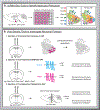Selective sexual differentiation of neurone populations may contribute to sex-specific outputs of the ventromedial nucleus of the hypothalamus
- PMID: 31605642
- PMCID: PMC6982598
- DOI: 10.1111/jne.12801
Selective sexual differentiation of neurone populations may contribute to sex-specific outputs of the ventromedial nucleus of the hypothalamus
Abstract
Sex differences among neurones in the ventrolateral region of the ventromedial hypothalamic nucleus (VMHvl) allow for the display of a diversity of sex-typical behaviours and physiological responses, ranging from mating behaviour to metabolism. Here, we review recent studies that interrogate the relationship between sex-typical responses and changes in cellular phenotypes. We discuss technologies that increase the resolution of molecular profiling or targeting of cell populations, including single-cell transcriptional profiling and conditional viral genetic approaches to manipulate neurone survival or activity. Overall, emerging studies indicate that sex-typical functions of the VMH may be mediated by phenotypically distinct and sexually differentiated neurone populations within the VMHvl. Future studies in this and other brain regions could exploit cell-type-specific tools to reveal the cell populations and molecular mediators that modulate sex-typical responses. Furthermore, cell-type-specific analyses of the effects of sexually differentiating factors, including sex hormones, can test the hypothesis that distinct cell types within a single brain region vary with respect to sexual differentiation.
Keywords: neuroactive steroids; neuropeptides; oestrogens; progestogens; steroids.
© 2019 British Society for Neuroendocrinology.
Conflict of interest statement
The authors of the manuscript have no conflicts of interest to declare
Figures


Similar articles
-
Origins and Functions of the Ventrolateral VMH: A Complex Neuronal Cluster Orchestrating Sex Differences in Metabolism and Behavior.Adv Exp Med Biol. 2017;1043:199-213. doi: 10.1007/978-3-319-70178-3_10. Adv Exp Med Biol. 2017. PMID: 29224096 Free PMC article. Review.
-
Androgen receptors are required for full masculinization of the ventromedial hypothalamus (VMH) in rats.Horm Behav. 2007 Feb;51(2):195-201. doi: 10.1016/j.yhbeh.2006.10.001. Epub 2006 Nov 21. Horm Behav. 2007. PMID: 17123532 Free PMC article.
-
Enhanced male-evoked responses in the ventromedial hypothalamus of sexually receptive female mice.Curr Biol. 2015 Mar 2;25(5):589-94. doi: 10.1016/j.cub.2014.12.048. Epub 2015 Feb 12. Curr Biol. 2015. PMID: 25683805
-
Female and male sexual responses in female cats with ventromedial hypothalamic lesions.Behav Neurosci. 1985 Oct;99(5):936-41. doi: 10.1037//0735-7044.99.5.936. Behav Neurosci. 1985. PMID: 3843309
-
Ventromedial Nucleus of the Hypothalamus Neurons Under the Magnifying Glass.Endocrinology. 2021 Oct 1;162(10):bqab141. doi: 10.1210/endocr/bqab141. Endocrinology. 2021. PMID: 34265067 Free PMC article. Review.
Cited by
-
Roles of estrogens, estrogen-like compounds, and endocrine disruptors in adipocytes.Front Endocrinol (Lausanne). 2022 Sep 21;13:921504. doi: 10.3389/fendo.2022.921504. eCollection 2022. Front Endocrinol (Lausanne). 2022. PMID: 36213285 Free PMC article. Review.
-
Hypothalamic Perineuronal Nets Are Regulated by Sex and Dietary Interventions.Front Physiol. 2021 Jul 28;12:714104. doi: 10.3389/fphys.2021.714104. eCollection 2021. Front Physiol. 2021. PMID: 34393830 Free PMC article.
-
Sexual differentiation of estrogen receptor alpha subpopulations in the ventromedial nucleus of the hypothalamus.Horm Behav. 2023 May;151:105348. doi: 10.1016/j.yhbeh.2023.105348. Epub 2023 Mar 21. Horm Behav. 2023. PMID: 36948113 Free PMC article.
-
From Reductionism Toward Integration: Understanding How Social Behavior Emerges From Integrated Circuits.Front Integr Neurosci. 2022 Apr 1;16:862437. doi: 10.3389/fnint.2022.862437. eCollection 2022. Front Integr Neurosci. 2022. PMID: 35431824 Free PMC article. Review.
-
Prostaglandin E2 receptor Ptger4b regulates female-specific peptidergic neurons and female sexual receptivity in medaka.Commun Biol. 2022 Nov 10;5(1):1215. doi: 10.1038/s42003-022-04195-x. Commun Biol. 2022. PMID: 36357668 Free PMC article.

